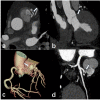Benign incidental cardiac findings in chest and cardiac CT imaging
- PMID: 35969186
- PMCID: PMC9975525
- DOI: 10.1259/bjr.20211302
Benign incidental cardiac findings in chest and cardiac CT imaging
Abstract
With the continuous expansion of the disease scope of chest CT and cardiac CT, the number of these CT examinations has increased rapidly. In addition to their common indications, many incidental cardiac findings can be observed when carefully evaluating the coronary arteries, valves, pericardium, ventricles, and large vessels. These findings may have clinical significance or risk of complications, but they are sometimes overlooked or may not be described in the final reports. Although most of the incidental findings are benign, timely detection and treatment can improve the management of chronic diseases or reduce the possibility of severe complications. In this review, we summarized the imaging findings, incidence rate, and clinical relevance of some benign cardiac findings such as coronary artery calcification, aortic and mitral valve calcification, aortic calcification, cardiac thrombus, myocardial bridge, aortic dilation, cardiac myxoma, pericardial cyst, and coronary artery fistula. Reporting incidental cardiac findings will help reduce the risk of severe complications or disease deterioration and contribute to the recovery of patients.
Figures











Similar articles
-
Reporting incidental coronary, aortic valve and cardiac calcification on non-gated thoracic computed tomography, a consensus statement from the BSCI/BSCCT and BSTI.Br J Radiol. 2021 Jan 1;94(1117):20200894. doi: 10.1259/bjr.20200894. Epub 2020 Oct 29. Br J Radiol. 2021. PMID: 33053316 Free PMC article.
-
[Prevalence and clinical significance of incidental cardiac findings in non-ECG-gated chest CT scans].Radiologe. 2011 Jan;51(1):59-64. doi: 10.1007/s00117-010-2071-0. Radiologe. 2011. PMID: 20967410 German.
-
Pertinent reportable incidental cardiac findings on chest CT without electrocardiography gating: review of 268 consecutive cases.Acta Radiol. 2013 May;54(4):396-400. doi: 10.1177/0284185113475918. Epub 2013 Apr 30. Acta Radiol. 2013. PMID: 23436832
-
Incidental coronary calcifications on routine chest CT: Clinical implications.Trends Cardiovasc Med. 2017 Oct;27(7):475-480. doi: 10.1016/j.tcm.2017.04.004. Epub 2017 Apr 28. Trends Cardiovasc Med. 2017. PMID: 28583439 Review.
-
Opportunistic screening at chest computed tomography: literature review of cardiovascular significance of incidental findings.Cardiovasc Diagn Ther. 2023 Aug 31;13(4):743-761. doi: 10.21037/cdt-23-79. Epub 2023 Jul 21. Cardiovasc Diagn Ther. 2023. PMID: 37675086 Free PMC article. Review.
Cited by
-
Incidental imaging findings from head to toe: challenges and management: introductory editorial.Br J Radiol. 2023 Feb;96(1142):20239002. doi: 10.1259/bjr.20239002. Br J Radiol. 2023. PMID: 36692871 Free PMC article. No abstract available.
-
Incidental findings in preoperative computed tomography images of robotic-assisted total joint replacement: a multi-center retrospective study.BMC Surg. 2024 Nov 29;24(1):380. doi: 10.1186/s12893-024-02663-1. BMC Surg. 2024. PMID: 39614207 Free PMC article.
References
-
- Jacobs PC, Prokop M, van der Graaf Y, Gondrie MJ, Janssen KJ, de Koning HJ, et al. . Comparing coronary artery calcium and thoracic aorta calcium for prediction of all-cause mortality and cardiovascular events on low-dose non-gated computed tomography in a high-risk population of heavy smokers. Atherosclerosis 2019; 209: 455–62. doi: 10.1016/j.atherosclerosis.2009.09.031 - DOI - PubMed
Publication types
MeSH terms
LinkOut - more resources
Full Text Sources
Medical

